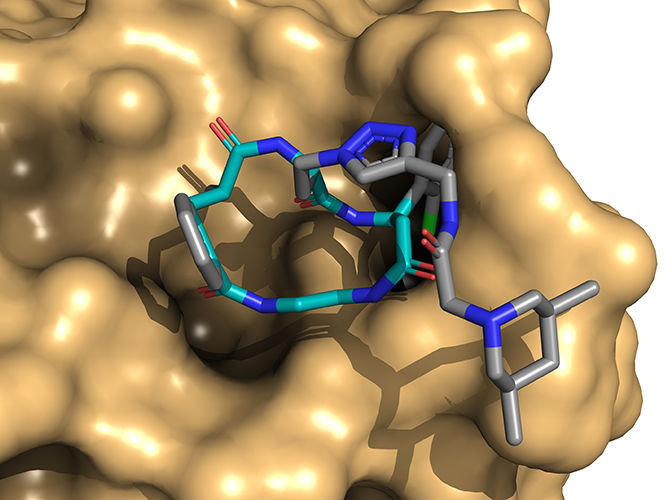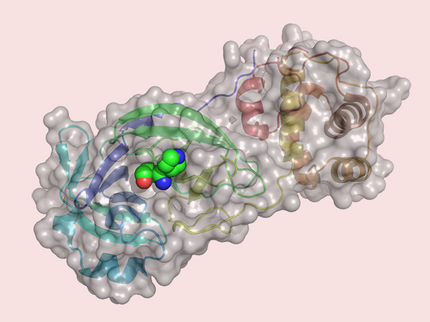Learning from Nature’s Bounty: New Libraries for Drug discovery
natural products, or their close derivatives, make some of our most potent medicines, among which macrocycles with their large carbon-rich ring systems are one class. The size and complexity of macrocycles has made it difficult to emulate and build on Nature’s success in the laboratory. By completing a complex molecular synthesis of these compounds attached to a unique identifying DNA strand, the Chemists of the University of Basel have built a rich collection of natural product-like macrocycles that can be mined for new medicines as the researchers report in the scientific journal “Angewandte Chemie”.

An artistic depiction of a macrocycle binding to a target protein.
University of Basel, Basilius Sauter | CC BY-SA 3.0
Natural evolution has created an incredible diversity of small molecular structures that perturb living systems and are therefore used as drugs in medicinal applications. Although several dozen approved medicines are macrocyclic structures, nearly all of these are natural products or close derivatives.
To find new lead compounds in drug research, huge libraries with diverse structures are required – or simply put, rich collections of molecules. Medicinal chemists have failed to imitate Nature’s approach to bioactive macrocyclic molecules – and their long syntheses precluded the creation of large screening libraries, which are essential for identifying drug leads.
A challenge for synthetic chemistry
Researchers at the chemistry department of the University of Basel have now completed a total synthesis of over one million macrocycles that incorporate structural elements often observed in natural biologically active macrocycles.
The synthesis is based on the split-and-pool principle: Before a synthesis step, the whole library is split. Then each fraction is coupled with one of various building blocks and the newly built molecules are labeled with a covalently attached DNA sequence. Before the next synthesis step all fractions are pooled again.
This leads to the cross combination of all diversity elements. Each combination is attached to a specific DNA barcode. Through this approach all 1.4 million members of the pooled library could be screened in a single experiment. Next generation DNA sequencing on the selected libraries could then identify macrocycles that bind target proteins.
Macrocycles are unlikely yet potent drugs
Most small molecule drugs are hydrophobic molecules (“water repellants”) with a low molecular weight (less than 500 daltons). Because of this, these drugs tend to slip without problem through cell membranes, exposing them to the great majority of disease-relevant proteins. Macrocycles buck this trend because they are often extremely large (more than 800 daltons) by medicinal chemistry standards, and yet they passively diffuse through cell membranes.
Researchers speculate that this special property of natural macrocycles derives from their ability to adapt their spatial structure (conformation) depending on the medium. Hence in the largely water-based environment of the blood stream and cell interior the macrocycles would expose their more water compatible (hydrophilic) groups to remain soluble. Once the hydrophobic cell membrane is encountered a conformational shift could allow the molecules to expose their hydrophobic face, making them soluble in membranes and hence capable of passive diffusion.
New applications possible
Given their unique properties, macrocycles are conspicuously under-represented in medicinal chemistry. This is largely due to the synthetic challenge of creating a large collection of macrocycles for screening. With the help of a barcoding DNA strand the Gillingham group has overcome this hurdle by developing an efficient seven-step synthesis of a natural product-like macrocycle library all pooled in one solution.
“With a large diverse collection of macrocycles available for screening, a more data-rich investigation of the properties of these extraordinary molecules can begin”, comments Dennis Gillingham. “This might reveal future medicinal applications, targets or active principles.”




















































